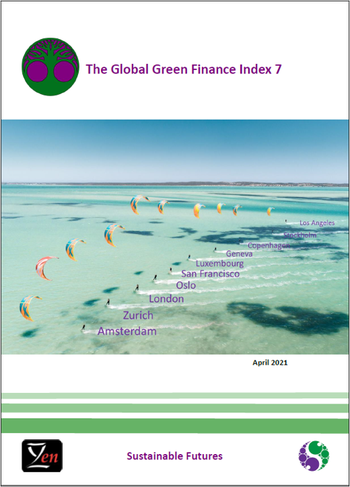Authors
Simon Mills, Mike Wardle & Professor Michael Mainelli
Published by
Long Finance & Financial Centre Futures (April 2021), 78 pages.
Share on social media:
You might also be interested in:
The Global Green Finance Index 7 - Supplement "Guernsey’s Approach To Unlocking Private Capital"
The seventh edition of the Global Green Finance Index (GGFI 7) was published on 29 April 2021. GGFI 7 provides evaluations of the depth and quality of the green finance offerings of 78 major financial centres around the world. The GGFI serves as a valuable reference into the development of green finance for policy and investment decision-makers.
The GGFI is compiled using 140 instrumental factors. These quantitative measures are provided by third parties including the World Bank, the Economist Intelligence Unit, the OECD and the United Nations.
The instrumental factors are combined with financial centre assessments provided by respondents to the GGFI online questionnaire. GGFI 7 uses 4,536 assessments from 739 respondents.
In the supplement to this edition of the GGFI, we take sustainable finance and private capital as our theme. With the assistance of We Are Guernsey, the body which promotes Guernsey as an international financial centre (IFC), we explore the drivers directing the flow of private capital into green finance and how these can be harnessed by IFCs for green and socially inclusive development.
Commentary
In previous editions of the index we have provided ratings of both the depth and quality of green finance in financial centres. For GGFI 7, we now offer a single measure of centres’ performance derived from these two dimensions.
As ESG analytics and reporting and other aspects of green finance penetrate mainstream financial activity, there is growing confidence in the development of green finance across all regions. Ratings of green finance rose in nearly all centres for both depth and quality.
Although Western Europe continues to dominate the top 10 centres in the index, its crown may be slipping as it faces stiff competition from both North America and the Asia/Pacific regions. A number of leading Western European centres may be displaced from the top 10 over the next two or three editions of the GGFI, as North American and Asia/Pacific centres continue to enhance their capabilities in this field.
Index Results
- Amsterdam took first place in GGFI 7, narrowly pipping Zurich, with London a close third.
- San Francisco rose four places into the top ten, with Los Angeles entering the top ten for the first time.
- Asia/Pacific centres performed strongly, with Tokyo, Beijing, Sydney, and Singapore all consolidating gains and challenging or displacing incumbents from Western Europe.
- The margins separating centres at the top of the index is narrowing. Among the top 10 centres the spread of ratings is 29 out of 1,000, compared to 51 out of 1,000 in GGFI 6.
- The mid-rankings in the index are brutally competitive, with the Latin America & Caribbean and Eastern Europe & Central Asia regions overtaken by Asia/Pacific and North America centres




